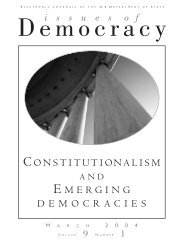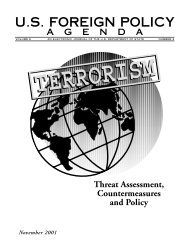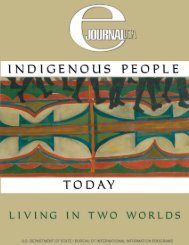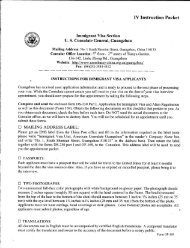Working for Women Worldwide - Embassy of the United States
Working for Women Worldwide - Embassy of the United States
Working for Women Worldwide - Embassy of the United States
Create successful ePaper yourself
Turn your PDF publications into a flip-book with our unique Google optimized e-Paper software.
Through its sizeable public and private contributions<br />
to <strong>the</strong> <strong>United</strong> Nations Children’s Fund<br />
(UNICEF), <strong>the</strong> <strong>United</strong> <strong>States</strong> also supports<br />
UNICEF’s education activities, which reach millions<br />
<strong>of</strong> girls. For instance, some <strong>of</strong> UNICEF’s advocacy<br />
publications have focused on girls’ education; and<br />
UNICEF has used sports to promote girls’ enrollment<br />
in schools in priority countries. It helped three<br />
million children enroll in school in Afghanistan after<br />
<strong>the</strong> war. It is working to do <strong>the</strong> same <strong>for</strong> an estimated<br />
one million children in Liberia, where it has distributed<br />
over 7,000 school supply kits and is training<br />
20,000 teachers. And in Iraq, UNICEF delivered<br />
hundreds <strong>of</strong> school-in-a-box kits to schools; it assisted<br />
in <strong>the</strong> holding <strong>of</strong> final exams after <strong>the</strong> war; and it has<br />
been involved in rehabilitating schools.<br />
The U.S. government also is focusing its ef<strong>for</strong>ts<br />
on women and children in some <strong>of</strong> <strong>the</strong> poorest and<br />
neediest places in <strong>the</strong> world. It has established its<br />
Equity in <strong>the</strong> Classroom program, <strong>for</strong> example, in<br />
Bangladesh, Benin, El Salvador, Haiti, Morocco,<br />
Peru, South Africa, and Uganda, among o<strong>the</strong>r countries.<br />
Administered by <strong>the</strong> U.S. Agency <strong>for</strong> International<br />
Development (USAID), this program <strong>of</strong>fers<br />
training and technical support in countries where educating<br />
girls is an explicit national priority.<br />
In 2002, President Bush announced a five-year<br />
African Education Initiative to help countries in that<br />
region improve primary school education through<br />
training <strong>of</strong> teachers, providing textbooks and o<strong>the</strong>r<br />
learning materials, supporting community involvement,<br />
and <strong>of</strong>fering scholarships <strong>for</strong> girls. U.S.<br />
embassies in some 30 African countries identified <strong>the</strong><br />
girls who were eligible <strong>for</strong> <strong>the</strong>se scholarships. In addition,<br />
more than 20,000 teachers have received training<br />
in countries such as Benin, Ethiopia, Guinea, Mali,<br />
Senegal, and South Africa.<br />
USAID works to promote basic education <strong>for</strong><br />
girls as well as boys in order to reduce poverty, improve<br />
health and social well-being, and sustain economic<br />
growth. USAID’s education programs <strong>for</strong> girls target<br />
both <strong>the</strong> lack <strong>of</strong> access and <strong>the</strong> poor quality <strong>of</strong> resources<br />
that hinder girls’ participation and achievement in<br />
school. This approach involves using multiple strategies<br />
to address barriers to girls’ education, including<br />
engaging influential citizens and organizations within<br />
<strong>the</strong> public and private sectors to support girls’ education<br />
and promoting “girl-friendly” national education<br />
policies.<br />
For example, a USAID program to raise <strong>the</strong><br />
acceptance <strong>of</strong> girls in <strong>the</strong> classroom in <strong>the</strong> Democratic<br />
Republic <strong>of</strong> Congo, El Salvador, Ghana, Guatemala,<br />
Guinea, Mali, Morocco, and Peru has had a number<br />
<strong>of</strong> successes, among <strong>the</strong>m <strong>the</strong> establishment <strong>of</strong> a universal<br />
law <strong>for</strong> <strong>the</strong> enrollment <strong>of</strong> girls under 18 in Peru,<br />
and <strong>the</strong> awarding <strong>of</strong> 47,500 scholarships through <strong>the</strong><br />
private sector to girls in Guatemala. A thousand<br />
handbooks, funded by USAID and distributed in<br />
Ghana, give guidance to school administrators and<br />
communities on ways to encourage girls to attend and<br />
stay in school. In El Salvador, 15 issues <strong>of</strong> a children’s<br />
two-page insert in <strong>the</strong> country’s leading daily newspaper<br />
were devoted to promoting education <strong>for</strong> girls.<br />
To ensure girls and boys go to school ra<strong>the</strong>r than<br />
sweatshops, in 2002 <strong>the</strong> <strong>United</strong> <strong>States</strong> established <strong>the</strong><br />
McGovern-Dole International Food <strong>for</strong> Education<br />
and Child Nutrition Program. Its funds help millions<br />
<strong>of</strong> malnourished girls and boys stay in school where<br />
<strong>the</strong>y will receive nutritious meals. In low-income<br />
countries, <strong>the</strong> program provides <strong>for</strong> donations <strong>of</strong> U.S.<br />
agricultural products, as well as financial and technical<br />
assistance <strong>for</strong> school food and maternal and child<br />
nutrition projects. U.S. implementing partners <strong>for</strong><br />
McGovern-Dole include governments, nongovernmental<br />
organizations (NGOs), and <strong>the</strong> World Food<br />
Program (WFP) through its global Food <strong>for</strong><br />
Education initiative. The WFP initiative promotes<br />
non<strong>for</strong>mal education <strong>for</strong> women and adolescent girls<br />
and provides a monthly oil ration to teachers. In 2004,<br />
McGovern-Dole funding <strong>for</strong> <strong>the</strong> WFP was used in<br />
Cote d’Ivoire, The Gambia, Kenya, Mozambique, and<br />
Malawi.<br />
As <strong>the</strong>se examples show, agencies across <strong>the</strong> U.S.<br />
government <strong>of</strong>fer a variety <strong>of</strong> programs that contribute<br />
to its goal <strong>of</strong> expanding educational opportunities <strong>for</strong><br />
all people at every level and <strong>of</strong> all ages and backgrounds<br />
throughout <strong>the</strong> world. It is a global ef<strong>for</strong>t that,<br />
in <strong>the</strong> words <strong>of</strong> Assistant Secretary <strong>of</strong> State <strong>for</strong><br />
Educational and Cultural Affairs Patricia Harrison,<br />
Top, class at <strong>the</strong> Agadir Secondary Girls’ School in Baghdad’s<br />
Saydiya neighborhood. Center left, Florence Nabiyar, left, <strong>of</strong><br />
Afghanistan and Arezo Kohistani. The two were part <strong>of</strong> a group<br />
that received scholarships to study at American universities in<br />
2003. Center middle, a student from <strong>the</strong> Hala Bint Khuwaylid<br />
Secondary Girls’ School in Baghdad with her USAID-funded<br />
school bag. Center right, Iraqi Fulbright scholars on February 2,<br />
2004, applaud remarks by State Department Assistant Secretary<br />
<strong>for</strong> Educational and Cultural Affairs Patricia Harrison. Bottom,<br />
a USAID literacy program participant in Sierra Leone.<br />
10












